


Shute first worked under Sir Dennistoun Burney on R100. They collaborate in 1939 and 1940 on radio-controlled gliding torpedoes. ( BW ) |
Summer 1939Shute works on An Old Captivity and sails his yacht Runagate. |
September 3 1939World War Two begins. Shute is sailing his new yacht Runagate with his wife Frances and is caught in fog off the coast of France when war is declared. |
|
Runagate is a 40 foot Hillyard Schooner specially built for Shute. Nevil and Frances are in Runagate, in a fog off the French coast, when war is declared. Runagate means either Renegade or Vagabond. ( HMC ) Click for larger image |
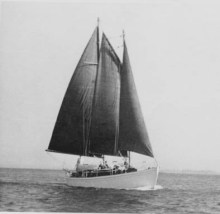 |
|
Runagate in 2003 Since 2003, Runagate's whereabouts are currently unknown. The father of Colin Henderson of UK is the last known owner. In 2003 Runagate was aging but her hull was in good to very good condition.(Photo: Colin Henderson 2003) (but see Newsletter for November 2007 for latest information on Runagate's whereabouts and also photograph on the "Virtual Museum")
|
 |
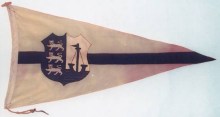 Click for larger image
Click for larger image
The burgee from Shute's yacht Runagate. Anyone who can identify the heraldry should contact us. We have established that it is not the Shute or Norway family crest. If the 3 animals are lions then the indication is probably that the sailors are brave but if they are, as they look to me, 3 pussycats in a boat then maybe the pennant had a humorous intent. (HMC /Photo: RM 2002) We have subsequently (July 2009) heard from Michael Ferrier, Former Commodore, Blackwater Sailing Club, that the pennant shown is the burgee of the Blackwater Sailing Club (founded 1899) Heybridge Basin, Maldon, Essex. (See www.blackwatersailingclub.org.uk) The arms depicted on the burgee are in fact those of the former Borough of Maldon and have been used by the club since the 1920s. It is not known why Nevil should be wearing this burgee. It could imply that he was a member of the Blackwater Sailing Club, which seems unlikely given that he lived on the South Coast. It is more likely that pehaps he visited the Blackwater Sailing Club and exchanged burgees, a practice common at that time. |
|
Shute sailing his yacht Runagate in the late 1930s. |
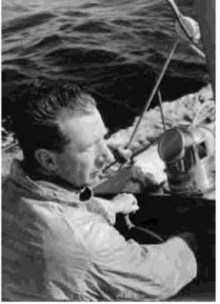 |
Autumn 1939To avoid stray bombs aimed at Portsmouth, the Shute family move to The Old Mill in Langston. The Old Mill is owned by Flora Twort. |
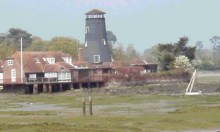 Click for larger image
Click for larger image
The Shute family temporarily live here at Langstone Mill in late 1939. Shute also does some gliding torpedo research work on the ground floor from 1939 to mid 1940. (Photo: DDT 2002) |
|
Shute attended some of the 40+ trials of the Toraplane gliding torpedo off the coast of the Isle of Wight. These trials had the co-operation and support of the Admiralty and had the active support of Winston Churchill who was then the First Lord of the Admiralty. Shute attended several meetings of The Toraplane Development Committee and was referred to as "Mr.Norway - Sir Dennis Burney's assistant". Landfall, which was almost certainly begun immediately after this time, mirrors these events. |
 |
This paravane deployed below the Toraplane and was used to detach the wings just before entry into the water. (JA) |
October 30 1939Shute attends the first of four meetings over 6 weeks under the Chairmanship of Admiral Sir William James regarding the plans for the Toraplane and the Doravane that were being designed by Sir Denistoun Burney. In the minutes Shute is described as Sir Denistoun Burney's assistant. |
December 04 1939Nevil Shute Norway, Sir Dennistoun Burney, Rolf Edmund Spencer, Arthur Henry Cooper and Henry Edward Gauss file for a patent titled "Improvements in or relating to Observing or Sighting Devices". This is for a gyro-stabilised aiming sight for the aircraft, which launched the Toraplane gliding torpedo. The device has a "computer" to correct for wind drift and other factors. |
 |
Sydney Hansel (1904 - 2004)
Born on 1
st
April 1904, Sydney Hansel worked with several aircraft companies and was very active and successful in design, test flying and sales. He first worked with Shute at Airspeed, then again with Shute and Sir Dennistoun Burney on the Toraplane and the Doravane and then again with Shute in the DMWD in WW2.
|
1939 - 1940Shute attempts to write The Lame Ducks Fly but stops after typing one chapter. |
|
British submarine HMS Snapper.
|
 |
Late 1939The Shute family move to Langstone Place in Langstone Harbour. |

Langstone Towers on Langstone Harbour provides a temporary home for the Shute family from late 1939 to mid 1940. (Photo: RM 2001) Click for larger image |
Early 1940With Sir Dennis Burney and Sydney Hansel, Shute is involved in the specification and design of the Burney Amphibian. A huge six-engined airborne aircraft carrier, it carries 4 torpedo-laden fighter-bombers within its wings. Never built, the aircraft is typical of Burney's adventurous approach to design. 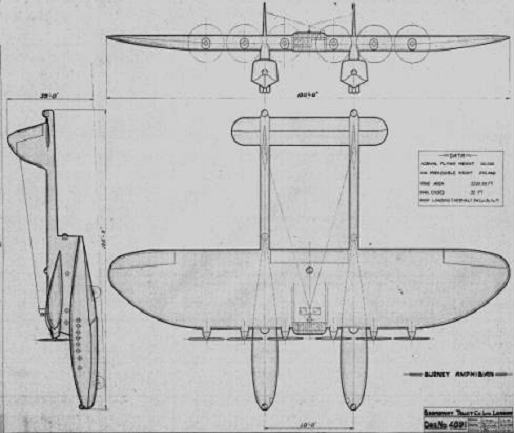
The Burney Amphibian aerial aircraft carrier was to weigh 220,000 pounds and be 125 feet long with a wingspan of 180 feet. With a top speed of 240mph, it was designed to carry a crew of 18 and its 4 Fighter-Torpedo-Bombers for up to 24 hours to a range of 5,300 miles. 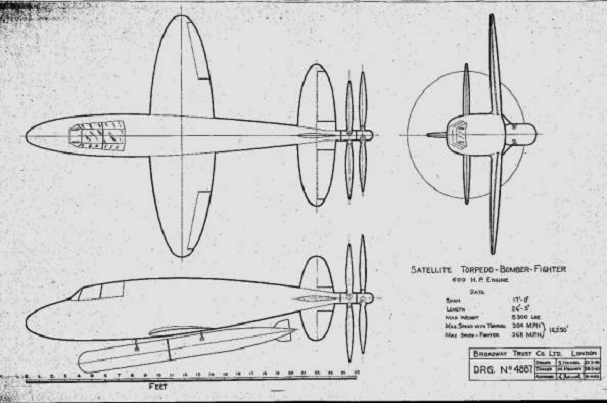
The Satellite Torpedo-Bomber-Fighter, 4 of which were housed in and launched from the wings of the Burney Amphibian, was 26 feet long with a 17 foot wingspan. With a top speed of 360mph and weighing 5,300 pounds, the Fighter had a real Buck Rogers look. |
1940An Old Captivity Published. |
Middle 1940The Shute family leaves Langstone Place. Shute sends his wife Frances, Heather (7) and Shirley (5) to Canada. This is a War Plan he had outlined in What Happened To The Corbetts / Ordeal in 1938. Unable to draw on Shute's funds in Canada, Frances and the girls go to Bermuda. |
 |
|
Shute attempts to join the Navy as an RNVR "Elderly Yachtsman" to command a trawler or mine sweeper but, to his chagrin, is immediately drafted into the Admiralty Department of Miscellaneous Weapon Development (DMWD).
Autumn 1940 - Later 1941
Shute has a leading role in developing the Acoustic Warning Device. Containing sensitive microphones and the ability to ignore non-threatening sounds, it was placed high up on a ships mast to detect approaching aircraft. The Gramophone Company (later to become EMI) was involved and 600 merchant vessels were fitted with the device. Detailed information on Shute's DMWD war work can be found in John Anderson's article "Nevil Shute and the DMWD" which can be found on the website. ( TSW ) |
1940Landfall is published. |
 Click for larger image
Click for larger image
The Ship Inn at South Harting in Sussex, mentioned in Landfall, is one of the very few pubs with its real name in a Shute novel. Shute mentions South Harting in a 1925 letter. (Photo: RM 2003) |
|
The Trout Inn
|

|